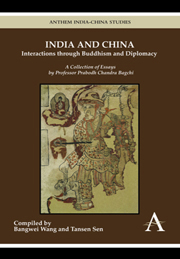 India and China: Interactions through Buddhism and Diplomacy
India and China: Interactions through Buddhism and Diplomacy Book contents
- Frontmatter
- Contents
- Compilers' Note
- Introduction (English and Chinese)
- Part One
- 1 Ancient Chinese Names of India
- 2 The Beginnings of Buddhism in China
- 3 Indian Influence on Chinese Thought
- 4 A Note on the Avadānaśataka and its Chinese Translation
- 5 Bodhisattva-śīla of Śubhākarasiṁha
- 6 A Fragment of the Kāśyapa Saṁhitā in Chinese
- 7 The Chinese Mysticism
- 8 Some Early Buddhist Missionaries of Persia in China
- 9 Some Letters of Hiuan-Tsang and his Indian Friends
- 10 New Lights on the Chinese Inscriptions of Bodhgayā
- 11 A Buddhist Monk of Nālandā amongst the Western Turks
- 12 Political Relations between Bengal and China in the Pathan Period
- 13 Chinese Coins from Tanjore
- 14 Report on a New Hoard of Chinese Coins
- 15 Ki-pin and Kashmir
- 16 Sino-Indian Relations – The Period of the United Empires (618–1100 A.D.)
- Part Two Short Articles
- Part Three Articles in Bengali
- Appendix
- Index
15 - Ki-pin and Kashmir
from Part One
Published online by Cambridge University Press: 05 March 2012
- Frontmatter
- Contents
- Compilers' Note
- Introduction (English and Chinese)
- Part One
- 1 Ancient Chinese Names of India
- 2 The Beginnings of Buddhism in China
- 3 Indian Influence on Chinese Thought
- 4 A Note on the Avadānaśataka and its Chinese Translation
- 5 Bodhisattva-śīla of Śubhākarasiṁha
- 6 A Fragment of the Kāśyapa Saṁhitā in Chinese
- 7 The Chinese Mysticism
- 8 Some Early Buddhist Missionaries of Persia in China
- 9 Some Letters of Hiuan-Tsang and his Indian Friends
- 10 New Lights on the Chinese Inscriptions of Bodhgayā
- 11 A Buddhist Monk of Nālandā amongst the Western Turks
- 12 Political Relations between Bengal and China in the Pathan Period
- 13 Chinese Coins from Tanjore
- 14 Report on a New Hoard of Chinese Coins
- 15 Ki-pin and Kashmir
- 16 Sino-Indian Relations – The Period of the United Empires (618–1100 A.D.)
- Part Two Short Articles
- Part Three Articles in Bengali
- Appendix
- Index
Summary
The identification of Ki-pin, a country mentioned in the Chinese records of the Han period, has been a matter of controversy for many years. Prof. Sylvain Lévi was the first to suggest the identification of Ki-pin with Kashmir and to point out that there was no confusion in the Chinese records about the identity till 581 A.D. But since the T'ang period when a new transcription of the name of Kashmir as Kia-she-mi-lo came in use, the Chinese authors lost sight of the old identity and began to consider Ki-pin as another name of Kapiśa. Prof. Chavannes with the help of other Chinese records endorsed the view of Prof. Lévi. Since then the identification was accepted as conclusive but scholars not acquainted with the Chinese records reopened the discussion and summarily rejected the identification. Some of them have identified it with Kapiśa and others more vaguely with Kapiśa-Kāśmīra without any qualification. As the identification of Ki-pin is closely connected with the problem of the first Śaka invasion of India, the identification has been mainly actuated by their views on the Śaka invasion. The first country in India to be occupied by the Śaka invaders was Ki-pin and as most of the scholars believe that the Śakas came by the North-Western route through Afghanistan they are constrained to identify Ki-pin of the earlier period with Kapiśa or Kafiristan against the positive evidence of early records against it.
- Type
- Chapter
- Information
- India and China: Interactions through Buddhism and DiplomacyA Collection of Essays by Professor Prabodh Chandra Bagchi, pp. 145 - 154Publisher: Anthem PressPrint publication year: 2011
